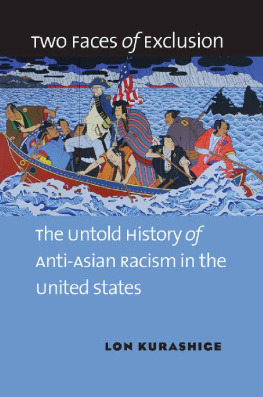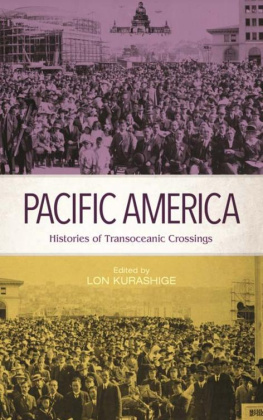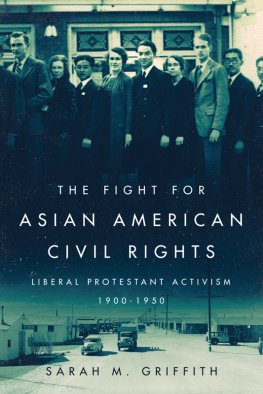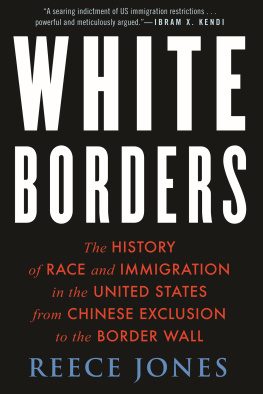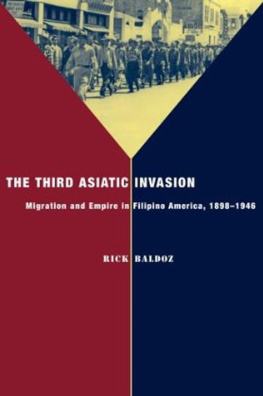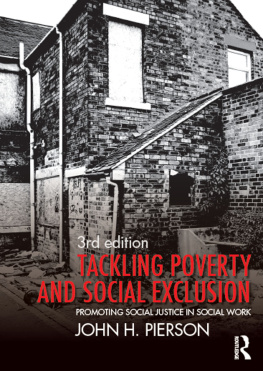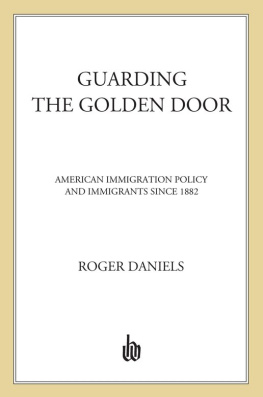The University of North Carolina Press has been a member of the Green Press Initiative since 2003.
Portions of chapters 3 and 7 and chapter 5 were previously published in somewhat different form, respectively, in Lon Kurashige, Transpacific Accommodation and the Defense of Asian Immigrants, Pacific Historical Review 83, no. 2 (May 2014): 294313; and Lon Kurashige, Rethinking Anti- Immigrant Racism Lessons from the Los Angeles Vote on the 1920 Alien Land Law, Southern California Quarterly 95, no. 3 (Fall 2013): 26583.
Illustrations
Tables
I.1 Asian vulnerabilities and U.S. immigration fears /
2.1 Party vote on Chinese labor exclusion, 1879 and 1882 /
2.2 Republican votes on Chinese labor exclusion by region, 1879 and 1882 /
2.3 U.S. cotton and silk manufacturing by region, 1880 /
2.4 Chinese exclusion keywords in select newspapers, 18761882 /
2.5 Regional difference in House Republican votes in the Forty-Seventh Congress /
5.1 Occupational distribution by select Los Angeles precincts, 1920 /
C.1 Policy community significance by historical era /
Maps
2.1 Chinese labor exclusion voting by congressional district, 1879 /
2.2 Chinese labor exclusion voting by congressional district, 1882 /
5.1 Support for alien land law in California by county and region, 1920 /
5.2 Opposition to alien land law in Los Angeles, 1920 /
5.3 Support for Republican presidential candidate in Los Angeles, 1920 /
7.1 Support for alien land law in California by county and region, 1946 /
A section of illustrations follows page
Preface
This book studies racial politicsthe crass, overt, in-your-face kind that discriminates against groups of human beings based upon supposedly objective criteria such as nationality, heredity, culture, and skin color. This type of racism, once the norm, is now ostracized to the fringes of most societies, including the United States. As a result, when studying contemporary America scholars tend to focus on more subtle, less visible, or what some call polite forms of racism that perpetuate racial discrimination and inequality stealthily and often without intention. There is much to appreciate about this kind of analysis, but it can be taken too far such that the historical distinction between vulgar and polite racism gets fuzzy and we lack understanding of the sometimes surprising process through which vulgar racism was overcome in law and politics, if not totally eliminated. A case in point is the history of anti-Asian racism in the United States, the subject of this book.
The idea for this investigation began in the archives, like so many works of history do. While reading through documents by a seemingly notorious anti-Asian racist, I discovered that later in life he curiously changed his views about race. After his conversion, he struggled to end the exclusion of Japanese immigrants and later was a rare leader of public opinion to oppose the internment of Japanese Americans to concentration camps during World War II. In researching this mans transformation, I found many other influential whites who had fought against anti-Asian discrimination. I also turned my gaze inward. After publishing two books and numerous articles on Asian American history and after teaching university courses on the subject for more than a decade, how could I have missed this persistent and robust opposition? It turned out that my ignorance had less to do with me than with an intriguing blind spot in historical knowledge. I started writing Two Faces of Exclusion to explore this collective amnesia and ended up rethinking the larger history of anti-Asian politics.
What has emerged is a story about an intense and shifting political conflict over the discrimination of Asian immigrants and ethnics, whom I refer to inclusively as Asian Americans. Before writing this book, I had assumed that the Japanese American internment, as well as immigration exclusion and other acts of prejudice, derived from an ongoing national consensus of opinion that considered Asians inferior to whites and antithetical to American institutions. But I have learned that these expressions of racism never went uncontested within the policy-making community and that even those who upheld whites as the superior race could oppose discrimination against Asian Americans. For more than three decades, from the middle to late nineteenth century, this opposition prevented Californians bent on excluding the Chinese from ending the nations immigration policy welcoming all peoples irrespective of race.
Yet from 1882 to 1924, a perfect storm of historical circumstances converged to enable lawmakers to shut Americas gates to Asian immigrants and further discriminate against those already in the country. While the Chinese had faced harassment in California since first coming in the 1850s, as well as the handicap preventing Asians from becoming U.S. citizens, they retained the same rights of entry as any immigrant until Congress in 1882 placed laborers from China in a special category for restriction. From that time, restriction turned into exclusion for nearly all but elite classes of Chinese, as the number of new arrivals dwindled. The ban spread to latter migrations from Japan, India, and Koreaand by statute any Asian with the exception of Filipinos, who, when they became U.S. colonial subjects, gained free right of entry to the imperial homeland. The Immigration Act of 1924 codified Asian exclusion. In establishing quotas for all nations outside the Americas, Congress prevented only the peoples of Asia from using them.
But historical conditions began to change again after 1924. Slowly, almost imperceptibly, the forty-two-year storm of exclusion weakened. While institutional racism persisted, and while Filipinos lost their right of entry and were summarily excluded, rays of sunlight appeared, such as the granting of naturalization rights to Asian immigrant veterans and the rise of support for Asian American workers in the house of labor. After exerting a powerful last gasp with the internment of Japanese Americans during World War II, the storm abated with surprising pace. Chinese exclusion lifted in 1943, and three years later so did the policies against Filipino and Indian immigration. By 1952 all Asians had access to national origins quotas and could become U.S. citizens. Consequently, the regime of institutional racism that was built on the denial of naturalization came crashing down with a suddenness that no one expected. Hawaii statehood (1959), which established a lasting and influential Asian American voice on Capitol Hill, and comprehensive immigration reform (1965), which equalized immigration quotas for everyone outside the Americas, produced the final end to the exclusion era. Since then the nation has witnessed its largest and most diverse influx of newcomers from Asiathe foundation of todays vibrant and growing Asian American population. While remnants of exclusion era racism remain and new storms have appeared, the mother of all storms is over. Given equal rights and opportunities, Asian Americans have attained dramatic social mobility and mainstream acceptance; and by taking advantage of a new era of relatively open (though highly selective and in their own way discriminatory) immigration and refugee policies, they were able to increase the groups overall population from fewer than 330,000 in 1950 to well over 17 million by 2010.

